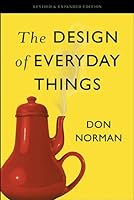
The Design of Everyday Things

I push doors that are meant to be pulled, pull doors that should be pushed, and walk into doors that neither pull nor push, but slide.
Don Norman • The Design of Everyday Things
Eventually I gave up: designers needed a word to describe what they were doing, so they chose affordance. What alternative did they have? I decided to provide a better answer: signifiers.
Don Norman • The Design of Everyday Things
Affordances determine what actions are possible. Signifiers communicate where the action should take place. We need both.
Don Norman • The Design of Everyday Things
The devices will be able to do many useful things, but I fear they will also frustrate: so many things to control, so little space for controls or signifiers. The obvious solution is to use exotic gestures or spoken commands, but how will we learn, and then remember, them?
Don Norman • The Design of Everyday Things
Goal (form the goal) 2. Plan (the action) 3. Specify (an action sequence) 4. Perform (the action sequence) 5. Perceive (the state of the world) 6. Interpret (the perception) 7. Compare (the outcome with the goal)
Don Norman • The Design of Everyday Things
As I watched people struggle with technology, it became clear that the difficulties were caused by the technology, not the people.
Don Norman • The Design of Everyday Things
The solution is human-centered design (HCD), an approach that puts human needs, capabilities, and behavior first, then designs to accommodate those needs, capabilities, and ways of behaving. Good design starts with an understanding of psychology and technology. Good design requires good communication, especially from machine to person, indicating w
... See moreDon Norman • The Design of Everyday Things
It is the duty of machines and those who design them to understand people. It is not our duty to understand the arbitrary, meaningless dictates of machines.
Don Norman • The Design of Everyday Things
The problem here is not just the lack of signifier, it is the faulty decision to produce a stopper that requires people to dirty their clean hands to use it.